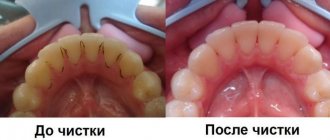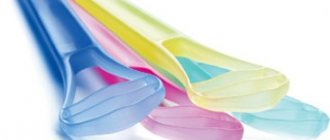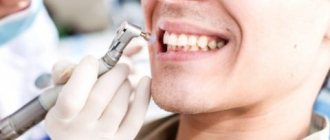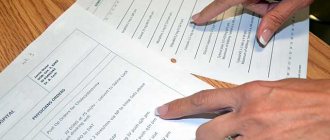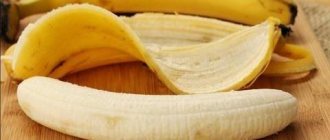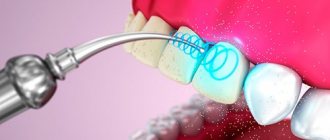Strong teeth are the key to the health of not only the oral cavity, but the entire body as a whole. For a beautiful and healthy smile, you need to brush your teeth twice a day, or better yet, after every meal. But no matter how often you brush, not all surfaces and corners of the oral cavity are accessible to a regular toothbrush. And then the plaque that went “undetected” turns into tartar.
Professional teeth cleaning from tartar
Why does tartar appear?
There are many reasons for the deposition of hard plaque, including:
- poor teeth cleaning at home;
- incorrectly selected brush and paste of inadequate quality;
- smoking;
- a large amount of soft food in the diet that does not require thorough chewing;
- dysfunction of the thyroid gland;
- uneven teeth and chewing food on only one side of the jaw.
Removing tartar is much more difficult , and it brings much more problems. In order to avoid possible complications in the future, professional teeth cleaning in dental offices by hygienists will help.
Can I eat and drink after a dental cleaning?
If we are talking about fluoridation of tooth enamel, then you are allowed to eat after a couple of hours. It is better to eat solid food, as it prevents the appearance of plaque. Dentists always recommend including as many fruits as possible in your diet, such as apples.
Among vegetables, you should avoid carrots and beets; they contain strong natural dyes that will instantly stain your teeth and even after thorough brushing you will not return them to their former whiteness. It is useful to consume dairy products - cottage cheese, kefir, milk.
Due to their calcium content, these products will help quickly restore damage to the tooth surface.
You can eat various cereals and soups without fear. After eating soft foods, if possible, brush and floss your teeth. Monitor the temperature of the food, it should be warm, as after cleaning the stone, sensitivity increases. In this case, choose a toothpaste for sensitive teeth.
Special recommendations for those with a sweet tooth! Sweets are prohibited in any form for several days. You will have to give up sweets, buns, cakes and any other sweets.
Professional teeth cleaning
Professional teeth cleaning is a procedure for mechanical or ultrasonic removal of tartar, plaque and pigmentation from the surfaces of teeth, as well as from hard-to-reach areas of the oral cavity. Hygienic cleaning must be done by everyone, without exception, at least 2 times a year .
Mechanical method of removing tartar
But this procedure is especially useful and vital for owners of orthodontic structures in the oral cavity, such as implants, braces, veneers . For those who wear braces, this procedure is very relevant. Since it is not possible to carry out high-quality teeth cleaning at home.
Professional cleaning is also carried out for those who decide to undergo dental treatment or enamel whitening.
Stains, coffee stains on teeth: how to whiten?
Whitening toothpastes.
Teeth whitening strips.
Those who really want to whiten their teeth and get rid of stains and plaque from coffee on their teeth can be advised to use the following methods:
- In the dentist's office using laser whitening methods, ultrasonic cleaning, etc.
- At home using special strips with a lightening composition, according to the instructions for use. These strips can be purchased at a pharmacy or ordered online.
- At home, apply a special gel to the surface of the teeth with a special brush.
- An option for the gel can be the use of a whitening pencil, however, this remedy is the least radical and effective, rather temporary cosmetic.
- Hydrogen peroxide. By the way, this product is often a component of toothpastes. Using hydrogen peroxide, perform the following actions: clean the oral cavity; dilute 25 - 30 drops of 3% hydrogen peroxide in half a glass of water and rinse your mouth with the solution; wipe each tooth with undiluted peroxide with a cotton swab; Rinse your mouth again with water or brush your teeth with toothpaste. This procedure can be performed no more than 2 times a day. It is important to know that dentists consider it ineffective. But perhydrol can burn the oral mucosa.
- Using tea tree oil. After you have brushed your teeth with a brush and toothpaste, you can put a couple of drops of oil on the brush and brush your teeth with it again. With such brushing, you may feel numbness in your tongue or gums; this is the effect of the oil, which allows you not only to whiten your teeth, but also to remove plaque. It must be remembered that essential oil is a strong allergen. You can use it only if you are sure that there will be no negative reaction from the body. A common side effect of teeth whitening with tea tree oil is irritation of the oral mucosa.
- Using baking soda. This abrasive substance is applied to several layers of gauze or bandage, and the teeth are rubbed with it. The disadvantage of this method is the rough effect on tooth enamel and its possible damage, as well as damage to the delicate gum tissue.
- Procedures similar to the previous one include the method of brushing teeth using tooth powder mixed with activated carbon crushed to a powder state.
- Baking soda, mixed with hydrogen peroxide to form a paste and used as toothpaste, works well to whiten stains on teeth. After applying it to the teeth, leave the paste for 3 minutes, then rinse your mouth well. This method can be used 2 times a week, not more often.
- Using lemon. You can wipe your teeth with a lemon slice or its peel, and then rinse your mouth thoroughly.
- Well, finally, you can regularly use toothpaste with a whitening effect if the sensitivity of your teeth allows it.
Baking soda and hydrogen peroxide are folk remedies for teeth whitening.
By the way, you can look for teeth whitening products on Aliexpress. Sellers on a Chinese trading platform offer to restore the color of tooth enamel after drinking coffee using whitening agents:
- powder
- paste
- gels
- stripes
- special lamps, etc.
Teeth whitening product from Aliexpress.
Contraindications
Teeth brushing in dentistry, as a medical procedure, has a number of contraindications:
- cardiac arrhythmia;
- colds and infectious diseases;
- diabetes;
- pregnancy;
- HIV, AIDS, hepatitis;
- increased sensitivity of teeth or inflammation of gums;
- destruction of enamel;
- childhood and adolescence.
Cleaning with the AirFlow device
The procedure for cleaning teeth from foreign substances, according to generally accepted standards, is carried out as follows:
- After a thorough examination of the oral cavity, the dentist identifies problem areas in the oral cavity.
- Cleans tartar using a special tool - an ultrasonic scaler. Since tooth enamel is harder than tartar, under the influence of ultrasound the stone collapses, but the tooth remains undamaged. Injury to the gums is minimal. For maximum patient comfort, doctors can use anesthesia in the form of special gels or sprays.
- Then pigment spots from tobacco, coffee and other products with a high dye content are removed. They can only be removed using a special device - Air Flow. It works by using pressure to push out abrasive materials to effectively clean the surface of your teeth.
- Fluoridation. This makes the enamel harder.
- At the final stage, the surface is polished with rubber brushes using a special paste.
In total, a complete cleaning cycle can take from 20 to 60 minutes .
Recommendations for care after removing deposits
After the doctor has removed hard deposits from the enamel, the patient may experience discomfort associated with increased tooth sensitivity. Therefore, he needs to follow special recommendations for 2–3 days.
Photo 1. During the first days after the procedure, you should be careful about brushing your teeth: carefully remove plaque and food with a soft bristle brush, try not to injure your gums.
First of all, you need to buy a new toothbrush, brush your teeth as usual, but use special compounds that reduce sensitivity.
Recommendations after professional teeth cleaning
The hygienic cleaning procedure may cause increased sensitivity to cold and hot, and short-term discomfort during cleaning. This is an acceptable side effect. After ultrasonic teeth cleaning, the doctor gives individual recommendations for further actions for 2-3 days.
This plan includes, but is not limited to, customized oral care products. But the general direction of the appointments is as follows:
- purchasing a new toothbrush;
- do not forget to brush your teeth 2 times a day using a paste that reduces enamel sensitivity.
Useful tips from Zubastik
Recommendation No. 1. After brushing, some people experience increased enamel sensitivity or bleeding gums. These phenomena are not permanent, do not be alarmed. To get rid of the inconvenience, you need to treat the oral cavity with the drug Metrogyl Denta. Has antimicrobial and antiseptic effects. You need to apply it 2 times for 5 days.
Recommendation No. 2. Use a soft toothbrush for 5 days. In the future - medium hardness.
Tags: nutrition, useful tips
About the author: Dr. Zubastik
Typically, a toothache begins to subside on the way to the clinic and finally goes away after 10 minutes of sitting in line to see the dentist.
- Related Posts
- All the nuances of flossing teeth
- Rating 2020: The best electric toothbrushes
- 12 best whitening toothpastes of 2020: which toothpaste is best for whitening teeth?
« Previous entry
What can you eat after a professional teeth reading?
You can start eating almost immediately after professional cleaning. But doctors still advise waiting at least 1 hour.
If fluoridation of the dental surface has been carried out, then it is necessary to abstain from food for at least 2 hours.
Anything that does not contain food or natural dyes is allowed to be used in food. Dentists especially recommend eating more solid foods - fruits and vegetables, such as apples, as they reduce the risk of plaque forming on the surface of the teeth.
Dairy products are rich in calcium
It is recommended to increase the amount of calcium-rich foods in your diet - milk, cottage cheese, kefir . But after using soft food, it is imperative to brush your teeth, rinse your mouth and use dental floss, since such food will actively clog into hard-to-reach places.
Also, to maintain the effect of brushing your teeth in the first days, it is recommended to drink mainly water, very lightly brewed tea or apple juice, but diluted with water.
Is it possible to drink tea after tooth extraction?
If treatment is not possible, then the last resort is to visit a dental surgeon. Removal is a mini-operation, performed under local anesthesia, and the doctor recommends refraining from drinking and eating for 2 hours after the intervention. During this time, a blood clot forms in the hole, closing the resulting wound.
Tea after tooth extraction can both harm and speed up wound healing. There will be harm when drinking a hot drink:
- Softening and washing out the formed clot can cause bleeding;
- Creating a favorable environment for harmful microorganisms. There are opportunistic bacteria in the oral cavity, which, once in a wound, can begin to actively multiply and cause inflammation. Drinking hot liquid creates favorable conditions for the inflammatory process;
- Increased blood circulation in the gums. Warming leads to vasodilation and increased blood flow to tissues. In the first hours after removal, this can lead to bleeding from the socket.
Tea with lemon for teeth Another problem that can occur when drinking hot liquid in the first hours after extraction is burns of the oral cavity.
For most people, the anesthetic wears off within 1-2 hours, but there are exceptions. For some, the slight decrease in sensation may last longer. Then the person does not feel how the drink burns his mouth, and the burn injuries then bother him for a long time and prevent him from eating. But cool tea is useful. Tannins (tannins) contained in tea leaves accelerate wound healing. For a faster recovery, you should drink black, which has more tannins. But we must observe moderation - drinking too much will not heal the wound faster and will ruin the color of your teeth.
Never try to rinse your mouth with tea after tooth extraction. Use only medications prescribed by your dentist.
What not to eat after a professional teeth reading
In the first 2-3 days after the hygiene procedure, you should completely exclude from your diet foods that irritate your teeth - everything sour, salty, sweet, cold, hot , carbonated drinks, as well as foods containing dyes:
- black and brown dyes are found in tea, coffee, Coca-Cola, Pepsi, cocoa, chocolate, soy sauce and balsamic vinegar, as well as in some berries (blueberries, blackberries, blueberries, black currants and black grapes);
- yellow dye is inherent in spices - mustard and curry;
- red and orange colors - red wine, ketchup, all red berries, tomatoes and their juice, beets, carrots, pumpkin and red cabbage;
- as well as all products with non-natural dyes - any carbonated drinks, candies, ice cream.
If it is not possible to give up your coffee addiction, then you can start drinking it after a few hours, but you should dilute it generously with milk and drink it through a straw.
Products that stain tooth enamel
Actions after the procedure
The first days after manipulation are especially important. During this period, it is important to provide reliable and thorough dental care, which includes:
- using a toothbrush with soft bristles (there is no need to further injure already irritated gums); using a special medicated toothpaste for sensitive teeth, which helps minimize irritation; To prevent staining of the enamel, during the first days, teeth should be brushed after each meal.
How soon can you eat? There is a misconception that you shouldn’t eat for a while after cleansing. But that's not true. In fact, you can eat immediately after the procedure, but not everything. After brushing your teeth, you should avoid eating foods that contain dyes. It’s better to immediately start enriching your body. It is useful to eat cottage cheese and kefir. Apples will be incredibly useful.
products, spices with dyes; dishes with unnatural substances, including confectionery and frozen juices; You can’t suddenly change the temperature of food: you can’t eat cold food after hot food (due to sensitivity, your teeth may hurt from such experiments); Do not drink coffee and tea (concentrated drinks can stain the enamel brown).
After brushing your teeth, you should not smoke. This will not only keep you healthy, but will also have a positive effect on the color of your teeth.
What can't you eat? Excluding foods and drinks with aggressive dyes from your diet will not only preserve the natural shade of your teeth, but will also not spoil the effect of the whitening procedure. Tooth enamel has many pores of varying sizes and depths. Because of this, teeth are easily stained and acquire unpleasant pigmentation.
The mechanism of staining occurs simply: chromogens, which are found in food and drinks, settle on the surface of the tooth, staining it. Tannins or tannins facilitate this process. The intensity of staining of tooth enamel is affected by the acidity of the foods consumed. The more acidic they are, the greater the likelihood of teeth softening and pigmentation.
The list of the most dangerous products includes:
- Coffee is the leader in harmfulness and danger. Coffee contains many components that stain teeth. And much stronger than cigarettes. Coffee and strong tea provoke the development of yellow plaque. This occurs due to high concentrations of heavy carbohydrates, cocoa butter. To reduce the adverse effects, it is recommended to drink coffee with milk. Tea. According to recent studies, green, white and herbal teas can stain enamel to varying degrees. To reduce the harmful effects, experts recommend using lightly brewed teas. It is better to give preference to green or white tea. There is no need to drink the drink hot. High temperature only enhances the effect of pigments. And even if you brush your teeth, the effect will remain. Red wine. Due to the content of tannins and chromogens, the product quickly and persistently stains dental structures. Due to the influence of polyphenols and pigments, this effect is greatly enhanced. To minimize the impact, it is better to drink rose or white wine. If it is not possible to refuse a red drink, it is better to brush your teeth with a whitening paste immediately after drinking wine. Sauces. All brightly colored spices will inevitably stain your teeth. Balsamic sauce and all its modifications have a particularly unfavorable effect. Therefore, it is best to use vegetable oil or juice for dressings.
Can you eat berries? Many of them (blueberries, grapes) have a rich color. Therefore, they stain the teeth in a characteristic shade. But you can’t give up berries. Only rinsing your mouth with special solutions will avoid the negative effects of these substances.
Lollipops leave their color on the tongue, which means they can stain tooth enamel. Also, to minimize the harmful effects, it is better to choose sugar-free chewing gum. To effectively combat bacteria, you need to use ultrasonic brushes and mouth irrigators.
Regular visits to the dentist are the key to healthy and white teeth. Professional cleaning should be carried out at least once every six months. Following certain restrictions will help you maintain your smile.
Daily oral care
ORAL CARE | Whitening, bleeding gums and more
Read only with us
What you can eat and drink after brushing your teeth Link to main publication
Strong teeth are the key to the health of not only the oral cavity, but the entire body as a whole. For a beautiful and healthy smile, you need to brush your teeth twice a day, or better yet, after every meal. But no matter how often you brush, not all surfaces and corners of the oral cavity are accessible to a regular toothbrush. And then the plaque that went “undetected” turns into tartar. Professional teeth cleaning from tartar
When can you smoke after ultrasonic teeth cleaning?
Specialists are strictly prohibited from smoking after the procedure. Since as a result of the procedure, the enamel loses its protective film, the tars from tobacco smoke will penetrate even more actively into the surface layer of the teeth, and they will turn yellow in 2-3 days.
Therefore, before resuming your addiction to a bad habit, you should wait 3-4 days . It is during this period that a new protective layer will appear on the teeth.
If, however, nicotine addiction is very strong, and there is no way to tolerate it, then after each smoking it is necessary to thoroughly brush your teeth.
Professional whitening
Professional teeth cleaning is a procedure for mechanical or ultrasonic removal of tartar, plaque and pigmentation from the surfaces of teeth, as well as from hard-to-reach areas of the oral cavity. Hygienic cleaning must be done by everyone, without exception, at least 2 times a year.
Mechanical method of removing tartar
But this procedure is especially useful and vital for owners of orthodontic structures in the oral cavity, such as implants, braces, and veneers. For those who wear braces, this procedure is very relevant. Since it is not possible to carry out high-quality teeth cleaning at home.
We suggest you read: Cotton wool remains after tooth extraction
Professional cleaning is also carried out for those who decide to undergo dental treatment or enamel whitening.
The hygienic cleaning procedure may cause increased sensitivity to cold and hot, and short-term discomfort during cleaning. This is an acceptable side effect. After ultrasonic teeth cleaning, the doctor gives individual recommendations for further actions for 2-3 days.
This plan includes, but is not limited to, customized oral care products. But the general direction of the appointments is as follows:
- purchasing a new toothbrush;
- do not forget to brush your teeth 2 times a day using a paste that reduces enamel sensitivity.
You can start eating almost immediately after professional cleaning. But doctors still advise waiting at least 1 hour.
If fluoridation of the dental surface has been carried out, then it is necessary to abstain from food for at least 2 hours.
Anything that does not contain food or natural dyes is allowed to be used in food. Dentists especially recommend eating more solid foods - fruits and vegetables, such as apples, as they reduce the risk of plaque forming on the surface of the teeth.
Dairy products are rich in calcium
It is recommended to increase the amount of calcium-rich foods in your diet - milk, cottage cheese, kefir. But after using soft food, it is imperative to brush your teeth, rinse your mouth and use dental floss, since such food will actively clog into hard-to-reach places.
Also, to maintain the effect of brushing your teeth in the first days, it is recommended to drink mainly water, very lightly brewed tea or apple juice, but diluted with water.
In the first 2-3 days after the hygiene procedure, you should completely exclude from your diet foods that irritate your teeth - everything sour, salty, sweet, cold, hot, carbonated drinks, as well as foods containing dyes:
- black and brown dyes are found in tea, coffee, Coca-Cola, Pepsi, cocoa, chocolate, soy sauce and balsamic vinegar, as well as in some berries (blueberries, blackberries, blueberries, black currants and black grapes);
- yellow dye is inherent in spices - mustard and curry;
- red and orange colors - red wine, ketchup, all red berries, tomatoes and their juice, beets, carrots, pumpkin and red cabbage;
- as well as all products with non-natural dyes - any carbonated drinks, candies, ice cream.
If it is not possible to give up your coffee addiction, then you can start drinking it after a few hours, but you should dilute it generously with milk and drink it through a straw.
Products that stain tooth enamel
Specialists are strictly prohibited from smoking after the procedure. Since as a result of the procedure, the enamel loses its protective film, the tars from tobacco smoke will penetrate even more actively into the surface layer of the teeth, and they will turn yellow in 2-3 days.
Therefore, before resuming your addiction to a bad habit, you should wait 3-4 days. It is during this period that a new protective layer will appear on the teeth.
If, however, nicotine addiction is very strong, and there is no way to tolerate it, then after each smoking it is necessary to thoroughly brush your teeth.
After ultrasonic removal of tartar, the dentist must consult the patient on all issues related to oral care after this procedure. For example, many are interested in how much not to eat after ultrasonic teeth cleaning, what foods should not be consumed after tartar removal, and how to maintain a beautiful smile for a long time.
Experts give the following basic recommendations after ultrasonic teeth cleaning:
- For the first 2-3 days, you need to brush your teeth after every meal. For oral hygiene, use a soft toothbrush and high-quality fluoride toothpaste. After 7 days, you can switch to a medium-hard brush.
- Patients who smoke often ask the question: “Is it possible to smoke after ultrasonic teeth cleaning?” Doctors do not advise taking up a cigarette for at least 2 days after the procedure, since cleaned, light-colored tooth enamel, free of plaque, will darken more intensely from smoke.
- For 2 days after ultrasonic teeth cleaning, you should not eat foods that increase tooth sensitivity - these are sweet, sour, hot and cold foods.
- It is also necessary to exclude tea, coffee, juices, carbonated drinks, chocolate, ketchup, tomatoes and other foods with a high content of coloring pigments from the diet for 2 days.
- If painful sensations or increased sensitivity of the teeth occur, the gums and interdental spaces should be treated with special preparations prescribed by the doctor.
There are other important professional tips - they relate to what to do after ultrasonic teeth cleaning in order to maintain its results for as long as possible. It's not that difficult - first of all, you need:
- change your toothbrush every 2–3 months
- use high-quality pastes and rinses
- use dental floss to clean between teeth
- brush your teeth at least 2 times a day
- include more raw vegetables and solid foods in your diet
- visit a dentist for a preventive examination at least 2 times a year.
Expert opinion
The effectiveness of ultrasonic teeth cleaning largely depends on how closely patients adhere to dentists’ recommendations. Proper oral care, including regular brushing of teeth, use of high-quality toothpastes and disinfectants, will ensure long-term results.
If you still have questions, be sure to ask them to your attending physician: he will answer, firstly, competently, and secondly, taking into account your individual characteristics. For example, although sonic scaling usually does not cause pain, in some cases patients may experience discomfort both during and after the procedure.
Teeth whitening is a complex procedure that involves deep cleaning of crowns from coffee and food deposits. It is performed using special gels, preparations and devices. The most well-known and popular technique is laser whitening. Photobleaching, chemical and endobleaching are also used.
Each professional whitening option has its own disadvantages and advantages, but all of them are safer than home methods. During the process of lightening the enamel, it is exposed to aggressive substances; microcracks can form on it, which in the first days after the procedure will absorb various dyes even more. In this regard, there are a number of restrictions regarding permitted products, alcohol, and smoking.
After whitening, many patients experience increased sensitivity of the enamel, and in this case, the doctor suggests remineralizing therapy.
If the problem of hypersensitivity has been bothering you for a long time, whitening is not performed, but the dentist offers alternative options - teeth cleaning using ultrasound or the Air Flow device. These are not whitening procedures; they are carried out to remove soft and hard dental plaque that cannot be removed with home hygiene products.
We invite you to read: Rules for installing a ceramic inlay on a tooth
Eating foods with dyes (beets, grapes, cranberries, cherries) in the first days after cleaning can lead to even further darkening of the enamel. But by eliminating them, you can preserve the result for a long time; in addition, selecting products that are healthy for teeth will strengthen the enamel.
What not to eat after brushing your teeth in the first 3 days:
- spices and products with dyes;
- hot and cold dishes;
- tea, coffee, sour juices, alcohol.
Restrictions apply to the following foods and drinks:
- chocolate;
- ketchup;
- tomatoes;
- beet;
- sauces (including soy sauce);
- curry;
- mustard;
- blueberry;
- blackberry;
- strawberry;
- currant;
- ice cream;
- cocoa, black tea, coffee.
Including avoid eating sour, hot and cold foods. They provoke increased sensitivity of dental tissue.
- purchasing a new toothbrush; do not forget to brush your teeth 2 times a day using a paste that reduces enamel sensitivity.
- black and brown dyes are found in tea, coffee, Coca-Cola, Pepsi, cocoa, chocolate, soy sauce and balsamic vinegar, as well as in some berries (blueberries, blackberries, blueberries, black currants and black grapes); yellow dye is inherent in spices - mustard and curry; red and orange colors - red wine, ketchup, all red berries, tomatoes and their juice, beets, carrots, pumpkin and red cabbage; as well as all products with non-natural dyes - any carbonated drinks, candies, ice cream.
- chocolate; ketchup; tomatoes; beet; sauces (including soy sauce); curry; mustard; blueberry; blackberry; strawberry; currant; ice cream; cocoa, black tea, coffee.
You are allowed to drink coffee only 3-4 days after brushing your teeth from stones. At this time, replace it with chicory. Dilute both drinks with milk and use a rinse after drinking.
The above lists what a patient can eat after a dental procedure; now you should remember that you should not eat it for the first time after professional cleaning of tooth enamel.
These are coloring products, they can be introduced into the diet no earlier than after 2 weeks:
- black coffee, strong tea; natural juice, as well as fruit drink from sour berries; sweets, including sweets with dyes; red wine; vegetables, fruits of bright color (beets, carrots).
Alcohol after brushing teeth
Doctors do not make a categorical ban on use. But they still advise you to give up this addiction completely, or wait a few days after the procedure. And they advise you to avoid drinks that contain dyes or cause discomfort (for example, cold drinks). It is worth limiting your use:
- red wines – high content of natural pigments;
- low-alcohol drinks and energy drinks in cans containing unknown chemicals that give very bright colors to liquids;
- Avoid drinking very cold drinks.
Is it possible to smoke
Nicotine is a coloring agent, like coffee and red wine. After the whitening or scaling procedure, you should not smoke for 4–5 days. Or better yet, say goodbye to the bad habit altogether.
But if this is not possible, brush your teeth with toothpaste after each cigarette you smoke. Otherwise, after 2–3 days, yellow plaque will appear on the enamel again.
Nicotine is as harmful to enamel as a glass of red wine or black coffee. Therefore, you definitely cannot smoke for the next 5 days from the day of the procedure. The enamel is especially susceptible during this period and has not yet been covered with a natural film, so any harmful effect will negate the doctor’s efforts and the patient’s costs.
It is advisable to give up smoking not only for 5 days, but to quit the bad habit for good - there is absolutely no benefit from it, only harm, including for dental health. When a person continues to smoke, dentists recommend that after a cigarette, go to the bathroom and brush your teeth with toothpaste. If you do not do this, after a couple of days the enamel will turn yellow.
Nicotine is as harmful to enamel as a glass of red wine or black coffee. Therefore, you definitely cannot smoke for the next 5 days from the day of the procedure. The enamel is especially susceptible during this period and has not yet been covered with a natural film, so any harmful effect will negate the doctor’s efforts and the patient’s costs. It is advisable to give up smoking not only for 5 days, but to quit the bad habit for good - there is absolutely no benefit from it, only harm, including for dental health.
We suggest you read: How much you can’t eat after filling a tooth with a light and temporary filling
Rules for oral care after brushing
Experts highlight several points for oral care, the observance of which will help maintain and prolong the results obtained:
- For one to two weeks, you should use only a soft toothbrush. It is necessary to clean 2 times a day, and if possible, after each meal. After this period, it can be replaced with a medium-hard brush. Which needs to be changed once every 2-3 months. Also, on the advice of a doctor, you should use high-quality toothpaste, priority should be given to toothpastes for sensitive teeth.
- It is imperative to use additional oral hygiene products. Among them:
- floss;
- irrigators;
- dental brushes.
Dental floss
All this equipment will allow for better cleaning of dental surfaces.
It is imperative to visit a hygienist at least 2 times a year. People wearing braces, implants and other structures should visit the dentist twice as often - 3-4 times a year.
Folk remedies for cleaning teeth, benefits and harms
Proponents of “natural medicines” criticize professional comprehensive oral care products. They claim that you can maintain hygiene, remove deposits and even get rid of diseases using folk remedies.
That's bullshit. There is no conspiracy of pharmaceutical companies to produce “harmful” toothpastes and brushes: all products undergo clinical testing, and no one will maliciously produce products that undermine health.
But home cleaning methods are at best useless, and at worst they will greatly harm your teeth. Individually or in combination, the following folk remedies for removing plaque are ineffective or harmful:
- soda;
- hydrogen peroxide;
- Activated carbon;
- citrus juice and peel;
- chalk, ash and any other abrasive;
- powdered milk;
- Coconut oil;
- calamus root;
- rose hip;
- salt – table and sea salt;
- clay;
- sulfur;
- honey;
- essential oils.
Teeth brushing is mandatory for pregnant women
